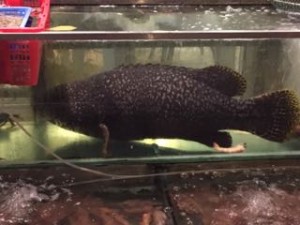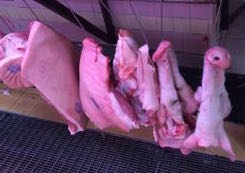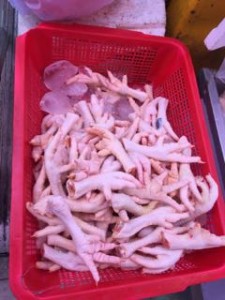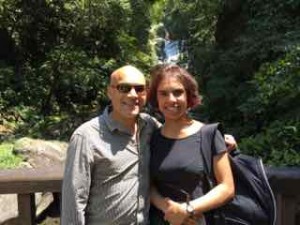The Cantonese are major foodies. I mean this in the sense they really care about the food they eat. They scour the globe for the choicest foods: live crabs from Cornwall, rock lobsters from New Zealand, sea cucumbers and abalone (sea snails) from South Africa and the infamous shark fins from whoever will sell them this illicit delicacy. (WWF has just persuaded the government to outlaw serving shark fin soup at its receptions).
 Frozen seafood retails at a fraction of the price of live food so where possible these items are flown in, chilled but alive, at tremendous carbon and financial cost and then presented in restaurants, supermarkets and wet markets. Customers either select the fish at the restaurant or bring their own. The chef despatches the animal, then serve it a few minutes later gutted, and stuffed with rice and spices.
Frozen seafood retails at a fraction of the price of live food so where possible these items are flown in, chilled but alive, at tremendous carbon and financial cost and then presented in restaurants, supermarkets and wet markets. Customers either select the fish at the restaurant or bring their own. The chef despatches the animal, then serve it a few minutes later gutted, and stuffed with rice and spices.
It’s not just fish. The Cantonese are proud of their reputation of eating absolutely anything. My colleagues delight in taking me to restaurants and serving me some harmless looking piece of meat and proudly identifying it afterwards as chicken’s feet, pig’s cheek, or squirrel’s testicle (I didn’t know squirrel’s had testicles, I didn’t even know they had gender).
Every neighbourhood has its wet market where you can buy these delicacies. These towering multi-storey Government inspected markets are laid out so the live and butchered animals are on the ground floor, the dry goods and vegetables on the floors above and the crowded cooked food centres sit at the top. One of Hong Kong’s top websites – openrice.com – which is packed full of user reviews, food photos and detailed price comparisons of eateries often showing the cheap and cheerful food courts, with their cracked formica tables, bric-à-brac plastic chairs and all the feng shui of a car crash with gushing reviews. And to this day the second best curry I’ve had in Hong Kong has been at the North Point wet market.
But just because Hong Kong people are into their food – it doesn’t mean the food is necessarily all that good. Or even edible for that matter. At least thirty per cent of Cantonese food is off-bounds to me either because it uses gross parts of animals (feet, snouts, intestines), inedible species (crickets, sea cucumbers) or endangered species.
A friend from WWF told me the street in Soho close to where I lived was one of the top spots for buying illegally traded ivory artefacts, cunningly labelled as mammoth ivory. (The difference can only be discerned by looking at the material’s grain so take a scanning electronic microscope next time you go shopping for ivory!) It seems CITES is relaxed about using species that are already extinct, its disapproval is reserved for species on the brink of extinction. As an economist I do worry about the sort of behavioural signal this sends poachers.
The commonest food eaten by HK people, as per everywhere else, is McDonalds. Their zillion restaurants, serve 1.5 million meals every year – which I calculate to be around 5% of all food eaten in Hong Kong. This shouldn’t surprise anyone – according to The Economist’s McDonalds price index HK is one of the world’s cheapest places to consume a Big Mac. McDonald here tastes exactly the same as it does in UK. The same can’t be said of KFC or its Yum! stablemate Pizza Hut which serve insipid copies of their usual fare.
The one species that is safe from HK people’s chopsticks is the dog. I am used to being less groomed than the typical HK citizen but I have to admit it riles a bit to see dogs better turned out then me. Soho has several dog spas to pamper Fido and a dog crematorium to send him off to the great kennel in the sky. One of the big scandals running in the papers is a story about a Vietnamese restaurant accused of killing and serving dog meat. The photos of the purported dog carcass have gone viral.
Maya arrived a fortnight ago and almost the first think we did was go off to Taiwan. Colleagues at work gush about Taiwan. The island is located just 100 km off the coast of China. Inevitably it’s been colonised by wave after wave of Chinese refugee fleeing some political or climatic Tsunami. The most recent wave of colonisation took place in 1949 when the nationalist KMT led by Chiang Kei-shek fled from Mao’s communist hordes to establish the Republic of China. The bizarre double-think of the Cold War meant that until 1971 the ROC (population 20 million) was recognised as pukka China instead of the commie People’s Republic of China (population one billion). PRC’s first action was to blackball Taiwan from every international institution apart from the Scout Movement. Taiwan’s a hauntingly beautiful place. Taipei itself is a sprawling city with rice paddies alongside state of the art semiconductor factories (Taiwan is one of the world’s largest producers of solar PV panels), towering mountains, and national parks with jungles and hot springs within the city limits. Earnings spread, according to the gini coefficient, are less iniquitous than Hong Kong’s or indeed UK’s. Prices, especially of property, are a fraction of HK’s. But the country has been in relative decline compared to the other Asian tigers this last decade. Even though political ties are tetchy, familial links between Taiwan and the mainland are close and Taiwanese capital has been invested in the mainland, most infamously Foxconn, rather than the island which is less tolerant of the company’s murderous sweatshop work regimes.
Taiwan was colonised by the Japanese for fifty years before their defeat in WWII and they’ve left their imprint on the street layout and architecture. Its also inspired some great movies like The Crossing which is a collaboration between the Japanese, Chinese and Taiwanese film industry. The film is basically War and Peace but set in China. The three-way war between is as much a national trauma to the present generation as the Napoleonic Wars were to Tolstoy’s.
Ending on an uplifting note, and sorry if this starts off like a bad joke. A couple of weeks ago I sat next to a Buddhist priest with a bag of dead frogs. I looked at them disapprovingly, wondering where they would be served-up. One of the animals croaked. The priest gave me a beatific smile. “Where are you taking them?” But he spoke no English. He took an iPhone out of his tunic and started to play around with it like everyone else on the MTR. Five minutes later, as I was about to get off when he touched my sleeve and pointed to the screen and then the bag of frogs. The screen had the word “release” written on it. I got off the tube gob smacked it could take him so long to use Google translate.






